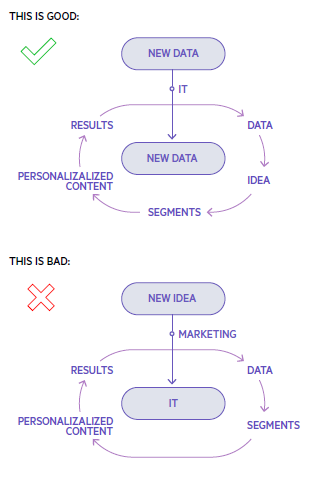5 Challenges of Personalization

This post is part of a series about tips to improve personalization (read post 1 and post 2).
If you tackle personalization in a one-off fashion, such as targeting just one banner to one persona, the process is relatively easy. However, once the analytics prove this has been successful and there is a big opportunity for you in persona based targeting, you will have to think about how to scale. This can bring certain challenges. When working with personalization you typically encounter five different types of challenges:
• Technology
• Process
• Scale
• Privacy & Compliance
• Data
 Technology Challenges
Technology Challenges
Typically, technology challenges are not created by the lack of technology, but rather by a lack of adoption. In essence, personalization is a connection mechanism between systems of record and systems of engagement. So, while personalization is a simple concept (show different content to different people), it’s technologically challenging to have a single connection mechanism between any and all systems of record that can transform the experience driven by systems of engagement.
Scalability Challenges
Scalability is probably the biggest challenge in employing an organization-wide personalization strategy. There are two types of scalability issues you should be aware of:
• Performance scalability: Content management systems scale to meet peak traffic by capturing a static snapshot of your website in memory and serving it. This process is known as caching. Otherwise, if the system has to talk to a database every single time, it will not be able to support a large numbers of visitors. If a website must change for every user based on personalization, this can become a problem—it’s difficult to capture a static snapshot of something very dynamic in nature. As such, the personalization platform you choose must be able to support scalability.
• Content management scalability: As the sophistication of your digital marketing grows, you not only see an increase of traffic and have to account for it with scalability, you also see increases in the number of users who create those experiences. It’s one thing to personalize one page for one segment, but it’s a completely different when you have five personas, six geographies, eight divisions, 20 sites and 1,000 different places you want to personalize. When you get to that point, you need structure. In fact, lack of structure is one of the biggest reasons so few organizations do personalization right today.
Data Challenges
There are two types of data challenges associated with personalization :
• The inability to utilize necessary data points. For example, perhaps you want to use Social Open Graph Data, CRM data, data coming from a proprietary system, purchase history data or any other data point. A common objection is that one system doesn’t sync to another, or a data point is not available to you for personalization.
• The inability to properly identify users. Most of your users will be anonymous; a complete 360-degree view including data from various channels, social networks and systems is only possible if visitors identify themselves. As a marketer, you must give your visitors compelling reasons to identify themselves or provide email addresses, links to their social accounts and so on.
Process Challenges
Even though personalization technology has been around for a while, companies do not use it as well as they should. This is a result of not having the correct processes in place. For example, it is not uncommon for marketing to have to rely on IT and development to help implement some personalization tactics, because they lack the technology that would enable them to do it themselves. These hand-offs and wait times slow down and impede marketing’s ability to deliver true personalized experiences.
Privacy and Compliance Challenges
While customer comfort level for sharing data has increased over the years, and analytics solutions are a de facto standard for any web experience, you still need to be completely transparent about how and why you collect user data. This is your privacy policy. In addition, personalization engines typically use cookies to track user behavior. There are a number of regulatory restrictions for using cookies. Some countries, especially in the European Union, have legislation that could require you to incorporate tracking consent before implementing personalization. Various recent data breaches have increased consumer sensitivity to how their personal information is gathered, stored and used.
Still, the majority of customers expect, and want, businesses to know their preferences and needs. You need to work organization-wide to create the right type of balance: delight your customers with personalized offerings, while keeping their data secure.
This series of posts are meant to provide you with a broad sense of the opportunities for personalization, and we’ll continue to break the guide down in the coming weeks. If you would like to read the entire guide or share it with colleagues, you can download it here.


Barrett Coakley
Barrett Coakley is the Senior Manager, Products Marketing for the Progress Sitefinity Content Management System (CMS) and the Sitefinity DEC, a digital marketing analytics platform. Mr. Coakley has worked in various marketing positions for both startup and large technology organizations for over 20 years.
